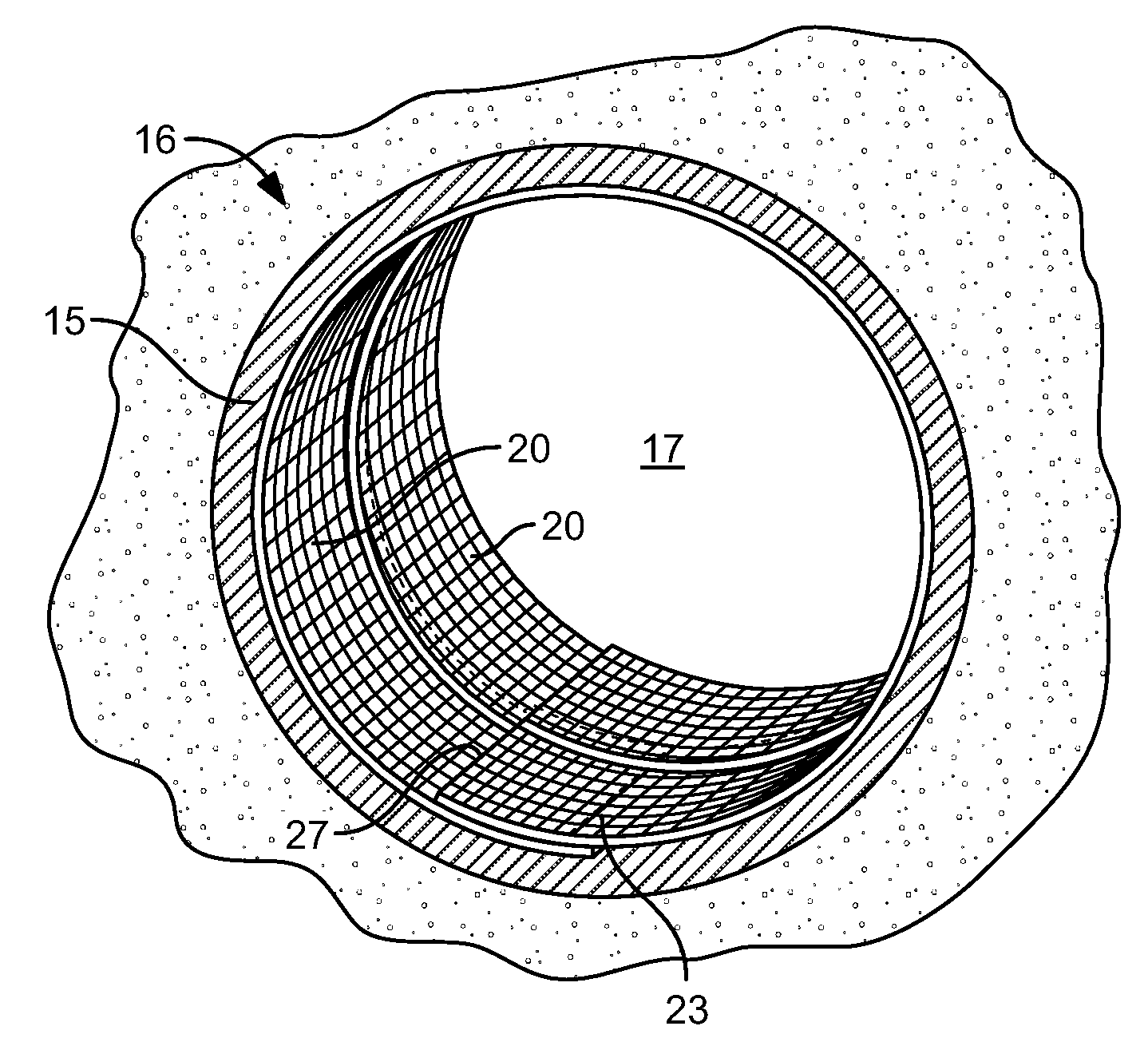Apparatus and Method of Reinforcing a Conduit or Vessel
a technology of pipe reinforcement and apparatus, applied in the field of pipelines, can solve the problems of reducing the service life of pipes, and reducing the provision for use inside pipes or vessels, so as to facilitate the reinforcing of pipes, reduce the down-time of pipes, and install quickly
- Summary
- Abstract
- Description
- Claims
- Application Information
AI Technical Summary
Benefits of technology
Problems solved by technology
Method used
Image
Examples
example 1
[0038]It is assumed that a concrete pipe 16 having an internal diameter of D=60 inches is subjected to an internal pressure of 25 psi. It is further assumed that considering factors of safety, the pipe 16 has to be designed to withstand a pressure of p=50 psi. It is further assumed that due to corrosion and other damage, the strength of the pipe 16 has diminished so much that it can be negligible, so that the new web 10 must resist the entire pressure of 50 psi. Using the relationships known to those skilled in design of pressure vessels, the force in the hoop direction is given by:
T=p D / 2=50 psi*(60 inch) / 2=1500 pounds per inch length of the pipe 16.
[0039]Assuming that the pipe 16 is being strengthened with laminates 20 placed inside the pipe 16 in the hoop direction (not spirally), the force of 3000 pounds is resisted by the fibers 30 positioned along the longitudinal direction of the laminate 20. Thus a laminate 20 with a minimum strength of 1500 pounds per inch width of the lami...
example 2
[0040]Assume that the pipe 16 of Example 1 is further subjected to axial forces such that a force of 200 pounds per inch is required along the axis of the pipe 16. This force could be due to flexural bending of the pipe, for example. In this case, the web 10 is constructed such that the longitudinal fibers 30 provide the previously-given strength of 1500 pounds per inch width of laminate 20 and the cross-linking or transverse fibers 40 provide a strength of 200 pounds per inch width of laminate 20 laterally. In placement of each laminate 20 for this example, the overlap 100 along the length of the pipe 16 must be large enough to allow the development of 200 pounds per inch of laminate 20. Similar to Example 1, the overlap 120 at the end of the band must also be large enough to allow the development of 1500 pounds per inch width of the web 10.
example 3
[0041]Assume that the pipe 16 of Example 1 is to be reinforced with a web 10 that has most of its fibers 35 oriented along the longitudinal axis. Each laminate 20 is assumed to be w=50 inches wide and installed on the pipe surface 15 in a spiral manner (FIG. 6) with an overlap length 100 of m=4 inches wide. The orientation of each laminate 20 results in a small reduction in the effective forces in the hoop direction. The efficiency factor can be calculated as:
R=πD / √[S2+(πD)2]
where S=w−m=50−4=46 inches.
[0042]This results in R=0.97, which means that in order to achieve a 1500 pounds per inch strength in the hoop direction, the web 10 must have a strength along its longitudinal axis at least equal to 1500 / 0.97=1544 pounds per inch width.
PUM
| Property | Measurement | Unit |
|---|---|---|
| Thickness | aaaaa | aaaaa |
| Length | aaaaa | aaaaa |
| Structure | aaaaa | aaaaa |
Abstract
Description
Claims
Application Information
 Login to View More
Login to View More - R&D
- Intellectual Property
- Life Sciences
- Materials
- Tech Scout
- Unparalleled Data Quality
- Higher Quality Content
- 60% Fewer Hallucinations
Browse by: Latest US Patents, China's latest patents, Technical Efficacy Thesaurus, Application Domain, Technology Topic, Popular Technical Reports.
© 2025 PatSnap. All rights reserved.Legal|Privacy policy|Modern Slavery Act Transparency Statement|Sitemap|About US| Contact US: help@patsnap.com



